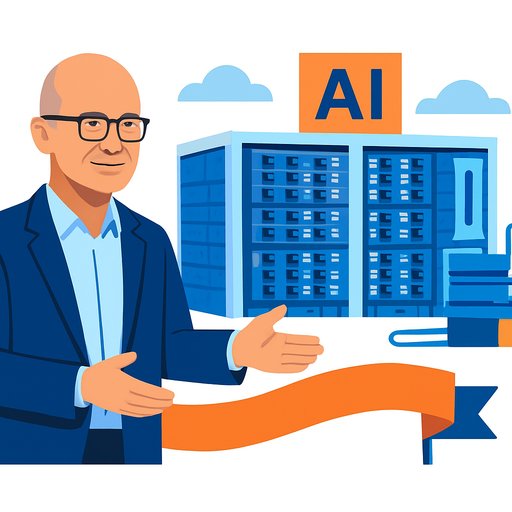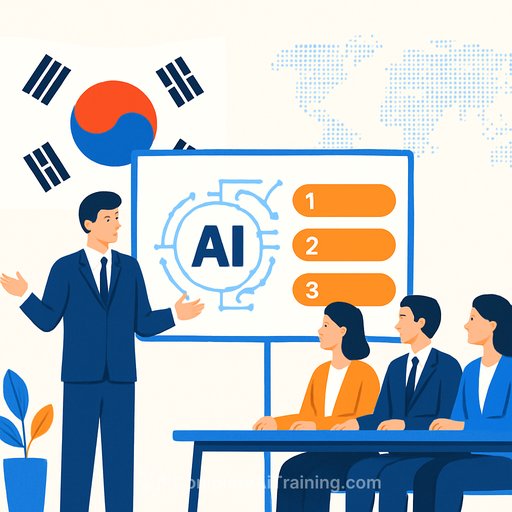Microsoft's First Nvidia-Powered "AI Factory" Lands. Here's What Executives Should Do Next
Satya Nadella revealed Microsoft's first massive Nvidia-powered AI factory: a supercomputing cluster of NVIDIA GB300s with 4,600+ GPUs connected by next-gen InfiniBand. He called it the first of many, signaling a broad rollout across Azure data centers.
The message is clear: Microsoft is scaling AI infrastructure to support advanced models and high-throughput training. It's a move to lock in a lead on capacity, performance, and time-to-deploy for enterprise AI workloads.
Inside the AI Factory
Each AI factory clusters more than 4,600 Nvidia GB300 rack systems with Blackwell Ultra GPUs and next-gen InfiniBand-Nvidia's ultra-fast interconnect for low-latency, high-bandwidth training at scale. That network layer is as strategic as the GPUs; it determines training throughput and reliability under peak load.
Microsoft plans to deploy hundreds of thousands of these GPUs globally. With 300+ data centers in 34 countries, the company says it's positioned to support next-generation models, including those with hundreds of trillions of parameters.
- More detail on InfiniBand: NVIDIA InfiniBand
Competitive Backdrop
OpenAI-both a partner and occasional competitor-has reportedly committed $1 trillion to its own data centers, with deals across Nvidia and AMD. Nadella's post underscores that Microsoft's footprint is already deploying, not just planned.
Why This Matters for Executives
- Capacity and time-to-model: More GPUs and faster interconnects compress training cycles and enable larger context windows and simulation-heavy workloads.
- Vendor concentration: Expect tight Nvidia supply. Balance Azure reservations with a multi-vendor, multi-cloud posture to reduce exposure and improve sourcing flexibility.
- Network is the bottleneck to watch: InfiniBand vs high-performance Ethernet has direct impact on tokens/sec, scaling efficiency, and job stability.
- Cost structure: Model training economics hinge on utilization. Factor in reservation commitments, preemptible/spot volatility, power and cooling, and data egress.
- Data gravity: Keep data close to compute. Plan for regional deployments to meet latency, privacy, and sovereignty requirements.
- Talent and process: MLOps maturity (observability, evals, rollback) will determine ROI more than raw GPU count.
What To Do Next
- Map workloads: Classify training, fine-tuning, and inference needs; align to Azure SKUs leveraging GB300/Blackwell Ultra. Define SLOs for latency, throughput, and budget.
- Secure capacity: Lock reservations early for critical programs. Build a waitlist strategy with alternative instance types and regions.
- Optimize the pipeline: Co-locate data lakes with compute, adopt RDMA-aware I/O, and track tokens/sec and TFLOPS utilization as first-class KPIs.
- Design for portability: Containerize training and serving, use vendor-neutral orchestration, and keep migration playbooks current.
- Governance: Establish model risk tiers, red-teaming, and cost guardrails. Tie deployment gates to eval results, not demo outcomes.
- Upskill leadership and teams: Align capability building with your roadmap. See curated executive-friendly programs here: AI certifications and executive tracks.
What To Watch
Microsoft CTO Kevin Scott is expected to share more on the AI infrastructure strategy at TechCrunch Disrupt later this month. Look for specifics on scheduler design, interconnect roadmaps, regional rollout cadence, and energy footprint-these inform procurement and deployment timing.
- Event page: TechCrunch Disrupt
Bottom Line
Microsoft's AI factories mark a scale-up phase for enterprise AI. If AI influences your margins in the next 12-24 months, treat GPU access, network performance, and MLOps excellence as board-level priorities-and act before capacity gets priced into everyone's plans.
Your membership also unlocks:






